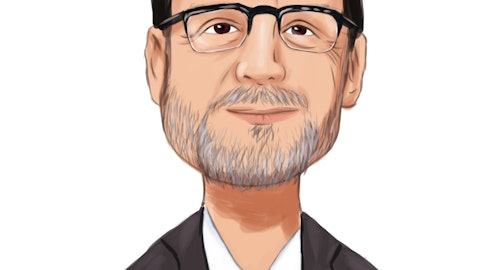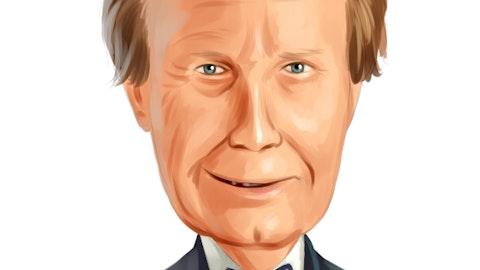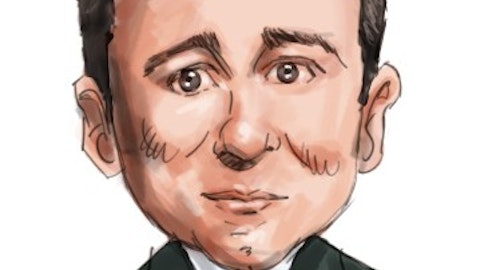Financial Institutions, Inc. (NASDAQ:FISI) Q4 2022 Earnings Call Transcript January 31, 2023
Operator: Hello, everyone and welcome to the Financial Institutions Fourth Quarter and Full Year 2022 Earnings Conference Call. My name is Bruno, and I will be operating your call today. I will now hand over to your host, Pamela Kennard, Investor Relations Analyst. Pamela? Please go ahead.
Pamela Kennard: Thank you for joining us for today’s call. Providing prepared comments will be President and CEO, Marty Birmingham; and CFO, Jack Plants. Chief Community Banking Officer Justin Bigham; and Director of Financial Planning and Analysis, Mike Grover will join us for Q&A. Today’s prepared comments and Q&A will include forward-looking statements. Actual results may differ materially from forward-looking statements due to a variety of risks uncertainties and other factors. We refer you to yesterday’s earnings release and investor presentation as well as historical SEC filings all available on our Investor Relations website for our Safe Harbor description and a detailed discussion of the risk factors relating to forward-looking statements.
We’ll also discuss certain non-GAAP financial measures intended to supplement and not substitute for comparable GAAP measures. Reconciliations of these measures to GAAP financial measures were provided in the earnings release filed with an exhibit to Form 8-K. Please note that this call includes information that may only be accurate as of today’s date January 31, 2023. I’ll now turn the call over to President and CEO, Marty Birmingham.
Marty Birmingham: Thank you Pam. Good morning, everyone and thank you for joining us today. Fourth quarter net income available to common shareholders was $11.7 million or $0.76 per diluted share down as compared to linked and prior year quarters. The decline was primarily the result of higher provision for credit losses and lower PPP-related revenue described in detail in our earnings release. Adjusting for revenue related to PPP loans restructuring charges and impact of the third quarter 2022 surrender and redeployment of company-owned life insurance pre-tax pre-provision income for the quarter was $20.8 million $261,000 higher than the linked quarter and $865,000 higher than the prior year period. I believe these are strong results in a challenging operating environment.
Organic loan growth was once again a highlight this quarter with 4.7% increase in total loans from September 30. All major loan categories contributed to this growth with increases of 4.8% in commercial business, 7.4% in commercial mortgage, 2.1% in residential real estate and 2.6% in Consumer Indirect. As our loan portfolio has grown over the past several years, I reinforce our commitment to credit discipline and the management of risk. We have continued to invest in credit and risk personnel and develop what we believe is an effective and efficient risk and control environment. A current example is the transition of Randy Phillips to a newly created position of Deputy Chief Credit Officer from his current role of Chief Risk Officer. With 32 years of local commercial credit experience Randy has the skills and experience to help lead and support a continued evolution of our credit delivery function.
The Chief Risk Officer role will be assumed on February 6 by a risk professional who has 34 years of progressive experience in compliance consumer credit, audit and operations, while working for international, national and regional banking institutions. He most recently served as Chief Compliance Officer in a $50 billion bank. In 2023, we expect that our loan portfolio performance will be consistent with historic credit outcomes despite market concerns regarding the economic environment a potential recession and the quality of credit. Positive year end total loan portfolio metrics, included non-performing loans to total loans of 25 basis points allowance for credit losses on loans to total loans of 112 basis points. An allowance for credit losses on loans to nonperforming loans of 445%.
In addition there were zero delinquencies in our large commercial loan portfolio as of December 31. The ratio of annualized net charge-offs to average loans was 34 basis points in the current quarter, 22 basis points in the third quarter of 2022 and 51 basis points in the fourth quarter of 2021. During the fourth quarter, we did have a $1.2 million charge-off of a credit with a previously established specific reserve, which was related to a small commercial loan associated with office space. Our overall loan portfolio is performing quite well, inclusive of this asset class. As I stated in the earnings press release, commercial loan growth was back-end weighted in 2022, largely driven by the success of our Mid-Atlantic team. After joining us in February, they worked quickly to develop a pipeline of high-quality opportunities in the Baltimore and Washington D.C. market.
Commercial loans outstanding in the Mid-Atlantic market increased by approximately $75 million in the fourth quarter and totaled $148 million at year-end. Our commercial loan pipeline in the Mid-Atlantic market is holding steady at about $200 million, while the total commercial loan pipeline is about $750 million. I’m very pleased with the progress made to date in this market, with new credit and deposit customer relationships established and cross-sell conversations related to insurance and wealth underway. Despite the ongoing pressures of inflation, higher interest rates and tight housing inventory, our residential loan portfolio grew 2.1% from September 30. This increase can be primarily attributed to our loan program that provides easier access to homeownership for borrowers with less than 80% of the area median income.
We are also seeing positive outcomes from recently added talent and operational efficiencies implemented to enhance our underwriting and application processes. The consumer indirect loan portfolio was $1 billion at year-end, up 2.6% or $26 million from the linked quarter due to continued strong demand. We are proactively moderating consumer indirect production through pricing and remain laser focused on credit quality and stringent underwriting standards. Net charge-offs were 57 basis points in the current quarter, down from the linked quarter and in line with historical trends. I’d like to remind everyone that our indirect business is a prime lending operation with an average portfolio of FICO score above 700. This business has delivered consistent results through several economic cycles with annual charge-offs ranging from a low of 14 basis points to a high of 87 basis points between 2008 and 2022.
Annual indirect charge-offs were 45 basis points in 2022. The long history of demonstrated outperformance of this portfolio, coupled with the exceptional quality of our commercial loan book and unwavering credit standards across all of our lending platforms, provide me with the utmost comfort as we enter the 2023 operating environment. This concludes my introductory comments. It’s now my pleasure to turn the call over to Jack for additional details on results and our guidance for 2023. Jack?
Jack Plants: Thank you, Marty. Good morning, everyone. Loan growth contributed to an $81,000 increase in net interest income from the linked quarter. The impact of PPP loans is winding down, as only $1 million of these loans remained as of December 31. During the fourth and third quarters of 2022, $1.6 million and $6 million of PPP loans were forgiven, respectively, with a related fee accretion of $78,000 in the fourth quarter as compared to $312,000 in the third quarter. NIM, on a fully taxable equivalent basis, was 323 basis points in the fourth quarter of 2022, down 5 basis points from the linked quarter due to repricing and the seasonality of our public deposit portfolio, coupled with a shift in mix from lower cost transaction deposit accounts to higher-cost time deposits.

Photo by Towfiqu barbhuiya on Unsplash
Relative to the magnitude of FOMC rate increases that occurred in 2022, our total deposit portfolio has experienced a cycle-to-date beta of 22%, including the cost of time deposits. Excluding the cost of time deposits, the non-maturity deposit portfolio had a beta of 7%. The investment securities portfolio was down slightly from the linked quarter as a result of the use of portfolio cash flow to fund loan originations in the quarter. As I stated in the earnings press release, for 2023 we have modeled cash flows of approximately $1 billion from the investment and loan portfolios for reinvestment and new loan originations at market rates, benefiting NIM. Our cost of funds was 109 basis points in the current quarter, up from 58 basis points in the linked quarter due to the impact of higher rates on public and reciprocal deposits and wholesale borrowings, combined with a shift in overall mix from lower cost transaction deposit accounts to higher-cost time deposits.
Non-interest income, which includes revenue from our insurance and wealth management businesses was $10.9 million in the fourth quarter, down $1.7 million from the linked quarter. The primary driver of this decline was the third quarter 2022 non-recurring $2 million enhancement associated with the surrender and redeployment of company-owned life insurance. Non-interest expense of $33.5 million was $686,000 higher than the linked-quarter, primarily as a result of $440,000 of non-recurring severance expense related to a restructuring that eliminated approximately 20 positions across the organization and $350,000 of non-recurring restructuring charges related to the 2020 closure of five branches. Income tax expense was $2.4 million in the quarter representing an effective tax rate of 16.4% compared to $4.7 million and an effective tax rate of 25.4% in the third quarter of 2022.
Approximately $1.5 billion of third quarter expense was associated with the previously mentioned company-owned life insurance surrender and redeployment strategy. The full year negative impact to accumulated other comprehensive loss was $124 million, driven by the unrealized loss position of our available for sale securities portfolio. As illustrated in our investor presentation, this unrealized loss position negatively impacted year-end TCE by 216 basis points and tangible common book value per share by $8.10. Excluding the AOCI impact, our TCE ratio and tangible common book value per share would have been 7.65% and $28.63 respectively. We continue to expect these metrics to return to more normalized levels over time given the high quality of our investment portfolio.
I would now like to spend the next few minutes providing our outlook for 2023 in key areas. We expect mid to high-single-digit growth in our total loan portfolio. Growth will be driven by the commercial loan categories and include our expansion into the Mid-Atlantic region and the recent opening of a Syracuse LPO. We plan for mid-single-digit growth in non-public deposits. We are focused on attracting new consumer and commercial deposit accounts and expect the positive impact of these new accounts to be partially offset by a lower average balance per comp as an outcome of the economic environment. Banking-as-a-Service or BaaS initiatives are expected to generate approximately $150 million of deposits in 2023, a significant contributor to our non-public deposit growth goals.
We are projecting reciprocal and public deposits to be relatively flat with typical seasonal fluctuations on a quarterly basis. We expect full year NIM of 330 to 335 basis points, using a forward rate curve that reflects economists predictions for 25 basis point rate increases in February and March with Fed activity remaining muted thereafter. Net interest margin is expected to be relatively flat in the first quarter, with expansion in the remaining quarters as we reposition our balance sheet by utilizing cash flow from the loan and investment portfolios, coupled with core deposit growth to fund anticipated loan originations. As a reminder, our NIM fluctuates from quarter-to-quarter due to the seasonality of public deposits and its impact on both our earning asset and funding mix.
In quarters where our average public deposit balances are higher due to seasonal inflows the second and fourth quarters, our earning asset yields are lower given the short-term duration of the deposits and limited opportunity to invest the funds. We are projecting relatively flat non-interest income. Excluding non-recurring items, such as the impact of the 2022 company-owned life insurance surrender and redeployment transaction and other non-interest income categories that are difficult to predict, such as limited partnership income, gains on investment securities and gain on sale of indirect loans. We are targeting an increase in the mid-single-digit range for non-interest expense. Our spend in 2023 reflects inflationary impacts experienced in 2022, partially offset by savings from the staffing restructuring completed in the fourth quarter.
2023 non-interest expense also includes ongoing investments in strategic initiatives, including our customer relationship management solution, digital banking, and BaaS. We expect these investments to begin producing incremental revenue in 2023 contributing to positive operating leverage and ROA above 1%, and an efficiency ratio below 60%. We expect the 2023 effective tax rate to fall within a range of 19% to 20%, including the impact of the amortization of tax credit investments placed in service in recent years. We will continue to evaluate tax credit opportunities and our effective tax rate would be positively impacted by taking advantage of further investment opportunities. We expect net charge-offs to be within our annual historical range of approximately 35 to 40 basis points.
Our overall focus includes executing on key strategic initiatives that will improve profitability and operating leverage over time. We believe that achieving results in line with the guidance provided will drive these outcomes. That concludes my prepared remarks. I’ll now turn the call back to Marty.
Marty Birmingham: Thank you, Jack. We are proud of our many accomplishments in 2022. In addition to delivering strong financial and operating results in a challenging environment, we achieved the following: in February, Five Star Bank launched a commercial lending platform in Baltimore and Washington D.C. by taking advantage of experience and available talent to hire a team of four commercial banking officers. As previously mentioned, this team is experiencing great success in establishing relationships with strong sponsors and closing loans. During the second quarter, we took advantage of the opportunity to sell a $31 million portfolio of indirect loans and recognize a gain of $586,000 demonstrating our ability to capture gains within this portfolio by leveraging capital market relationships to remix loan exposures.
In September, we celebrated the grand opening of Five Star Bank Center, the new home of our Western New York regional administrative office and SDN Insurance Agency. This was an investment in both the Buffalo region, and our future in this important market. The investment underscores our commitment to Western New York and our valued local associates, setting the stage for continued growth in the Buffalo market. Our BaaS pipeline expanded throughout the year and as noted in our investor presentation we have several partnerships in various stages of on-boarding. We also remain steadfast in our mission to support our customers and our communities. For the fifth consecutive year, our Five Star Bank Community Report highlights the ways in which we are fulfilling our purpose in promoting sustainable business practices that deliver long-term value to the communities we serve as well as our shareholders.
I encourage you to read the Five Star Bank 2022 community report available on the Five Star Bank website, and our Investor Relations website to better understand the many ways we keep people at the heart of everything we do. Our positive momentum continues in 2023. Just last week, we announced our expansion into the Syracuse market, with a new commercial loan production office in the city’s historic Franklin Square. This new office provides entrance into Onondaga County expanding Five Star Bank’s Upstate New York footprint to 15 counties throughout Western New York, the Southern tier, and the Finger Lakes region. The Syracuse office will be home to a three person commercial and industrial team, and a commercial real estate banker. In accordance with our strategic plan, we’ve expanded beyond our historic rural Upstate New York footprint, to serve metros like Buffalo Rochester, and now Syracuse.
This most recent expansion supports our focus on driving credit disciplined loan growth, and growing deposits by bringing our style of community banking, with local leadership and local decision-making to businesses of all sizes throughout Central New York. In closing, I would like to thank my fellow teammates for their ongoing dedication and commitment. Their efforts are instrumental to our achievements and ongoing success. Operator, please open the call for questions.
See also 25 Largest Privately Held Companies in the US and 10 Dirt Cheap Stocks To Buy.
Q&A Session
Follow Financial Institutions Inc (NASDAQ:FISI)
Follow Financial Institutions Inc (NASDAQ:FISI)
Operator: Our first question is from Alex Twerdahl from Piper Sandler. Alex, your line is now open. Please go ahead.
Alex Twerdahl: Hey, good morning, guys.
Marty Birmingham: Hey, good morning, Alex.
Alex Twerdahl: First off Jack, I was hoping you could give us a little bit more on the $1 billion of cash flow from the securities and loans. I guess first off, how much of that would you need just to keep the loan portfolio flat? I’m just trying to figure out how much might be excess after the loan growth guidance that you gave us.
Jack Plants: So if we’re bifurcating that guidance between the two portfolios, we’re currently modeling $180 million in cash flow from the securities portfolio and then about $900 million in cash flow off the loan portfolio.
Alex Twerdahl: Okay. And is that going to be should we expect those cash flows to be pretty consistent throughout the year, or are there any big chunks in there that we should be aware of?
Jack Plants: It modeled to be a little fairly consistent. There is lumpiness in the commercial portfolio. But from a timing standpoint we would expect that to be relatively flat over the year.
Alex Twerdahl: Okay. And then when we think about the reinvestments of that into new loans. Can you give us a little bit of sense for what kind of rates you’re getting? What kind of yields you’re getting on new production? And if that is different across the different portfolios as well as the different geographies that you’re in?
Jack Plants: Yes I can comment on the total portfolio. Just as recently as December, we were seeing new origination rates in the commercial portfolio come on around 7% and a little bit better in the indirect portfolio.
Alex Twerdahl: Okay. And the last question that I had is on the $150 million of deposits from the Banking as a Service relationships. Would those typically be time deposits or transactional deposits, or what kind of I guess what kind of rate would you need to pay on the types of deposits that those relationships would generate?
Jack Plants: Those are generally non-maturity deposits and the rate that we would have there is favorable to what we’re seeing in the time deposit space. So I’m not going to comment purely on what we’re paying but it does benefit margin.
Alex Twerdahl: Great. Thanks for taking my questions.
Marty Birmingham: Thank you, Alex.
Operator: Thank you, Alex. Our next question is from Damon DelMonte from KBW. Damon, your line is now open. Please go ahead.
Damon DelMonte: Good morning, guys. Thanks for taking my questions today. With respect to the deposit betas, I think Marty you made a comment that cycle to date you see about 22% deposit beta. What is like the full cycle expectation from you guys on your end?
Marty Birmingham: I think Jack made that comment 22% all-in and in maturity. Go ahead, Jack.
Jack Plants: Hey, Damon. Yes, so cycle to date through the end of the year we were at 22% for total deposits. As we look at our expectations for rate increases in 2023 and then go back and consider that full cycle which would essentially be two years, right? We’re looking at 25% to 30% cycle to date betas.
Damon DelMonte: Okay. So you feel like you got the majority of it pushed through already if you’re already at 22%, right?




